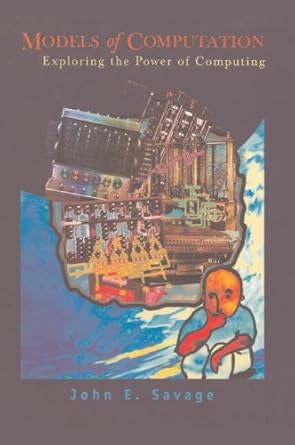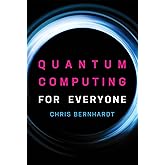
Download the free Kindle app and start reading Kindle books instantly on your smartphone, tablet, or computer - no Kindle device required.
Read instantly on your browser with Kindle for Web.
Using your mobile phone camera - scan the code below and download the Kindle app.

Models of Computation: Exploring the Power of Computing
- ISBN-100201895390
- ISBN-13978-0201895391
- PublisherAddison-Wesley
- Publication dateJanuary 1, 1998
- LanguageEnglish
- Dimensions8 x 1.75 x 9.75 inches
- Print length672 pages
Frequently purchased items with fast delivery
Editorial Reviews
From the Inside Flap
From the Back Cover
--Jan van Leeuwen, Utrecht University
"This is an impressive book. The subject has been thoroughly researched and carefully presented. All the machine models central to the modern theory of computation are covered in depth; many for the first time in textbook form. Readers will learn a great deal from the wealth of interesting material presented."
--Andrew C. Yao, Professor of Computer Science, Princeton University "Models of Computation" is an excellent new book that thoroughly covers the theory of computation including significant recent material and presents it all with insightful new approaches. This long-awaited book will serve as a milestone for the theory community."
--Akira Maruoka, Professor of Information Sciences, Tohoku University "This is computer science."
--Elliot Winard, Student, Brown University
In Models of Computation: Exploring the Power of Computing, John Savage re-examines theoretical computer science, offering a fresh approach that gives priority to resource tradeoffs and complexity classifications over the structure of machines and their relationships to languages. This viewpoint reflects a pedagogy motivated by the growing importance of computational models that are more realistic than the abstract ones studied in the 1950s, '60s and early '70s.
Assuming only some background in computer organization, Models of Computation uses circuits to simulate machines with memory, thereby making possible an early discussion of P-complete and NP-complete problems. Circuits are also used to demonstrate that tradeoffs between parameters of computation, such as space and time, regulate all computations by machines with memory. Full coverage of formal languages and automata is included along with a substantive treatment of computability. Topics such as space-time tradeoffs, memory hierarchies, parallel computation, and circuit complexity, are integrated throughout the text with an emphasis on finite problems and concrete computational models FEATURES: Includes introductory material for a first course on theoretical computer science. Builds on computer organization to provide an early introduction to P-complete and NP-complete problems. Includes a concise, modern presentation of regular, context-free and phrase-structure grammars, parsing, finite automata, pushdown automata, and computability. Includes an extensive, modern coverage of complexity classes. Provides an introduction to the advanced topics of space-time tradeoffs, memory hierarchies, parallel computation, the VLSI model, and circuit complexity, with parallelism integrated throughout. Contains over 200 figures and over 400 exercises along with an extensive bibliography.
** Instructor's materials are available from your sales rep.0201895390B04062001
About the Author
John E. Savage is a professor of Computer Science at Brown University. He is a Guggenheim Fellow, a Fellow of the IEEE, ACM, and the AAAS, and a recipient of a Fulbright-Hayes grant. Professor Savage is also the author of The Complexity of Computing (Wiley and Sons, 1976) and a co-author of The Mystical Machine (Addison-Wesley, 1986).
0201895390AB04062001
Product details
- Publisher : Addison-Wesley (January 1, 1998)
- Language : English
- Hardcover : 672 pages
- ISBN-10 : 0201895390
- ISBN-13 : 978-0201895391
- Item Weight : 3.1 pounds
- Dimensions : 8 x 1.75 x 9.75 inches
- Best Sellers Rank: #1,978,543 in Books (See Top 100 in Books)
- #772 in Computer Systems Analysis & Design (Books)
- #5,512 in Software Design, Testing & Engineering (Books)
- #8,605 in Computer Science (Books)
- Customer Reviews:
About the author

Discover more of the author’s books, see similar authors, read book recommendations and more.
Customer reviews
- 5 star4 star3 star2 star1 star5 star57%0%43%0%0%57%
- 5 star4 star3 star2 star1 star4 star57%0%43%0%0%0%
- 5 star4 star3 star2 star1 star3 star57%0%43%0%0%43%
- 5 star4 star3 star2 star1 star2 star57%0%43%0%0%0%
- 5 star4 star3 star2 star1 star1 star57%0%43%0%0%0%
Customer Reviews, including Product Star Ratings help customers to learn more about the product and decide whether it is the right product for them.
To calculate the overall star rating and percentage breakdown by star, we don’t use a simple average. Instead, our system considers things like how recent a review is and if the reviewer bought the item on Amazon. It also analyzed reviews to verify trustworthiness.
Learn more how customers reviews work on AmazonTop reviews from the United States
There was a problem filtering reviews. Please reload the page.
- Reviewed in the United States on May 19, 2018Excellent book
- Reviewed in the United States on February 23, 2024It is amazing how the author was able to cover many topics that one only finds in papers, and organize them in cohesive manner. That's being said, the author took the liberty to omit many details while proving theorems, while being on many unnecessarily occasions.
Although this book from the 90s, it is still relevant today.
- Reviewed in the United States on November 3, 1997Here is a book that has it all: a complete summary of theoretical computer science; well organized, detailed proofs; and quite understandable for the novice. This book should become the standard in its field.











